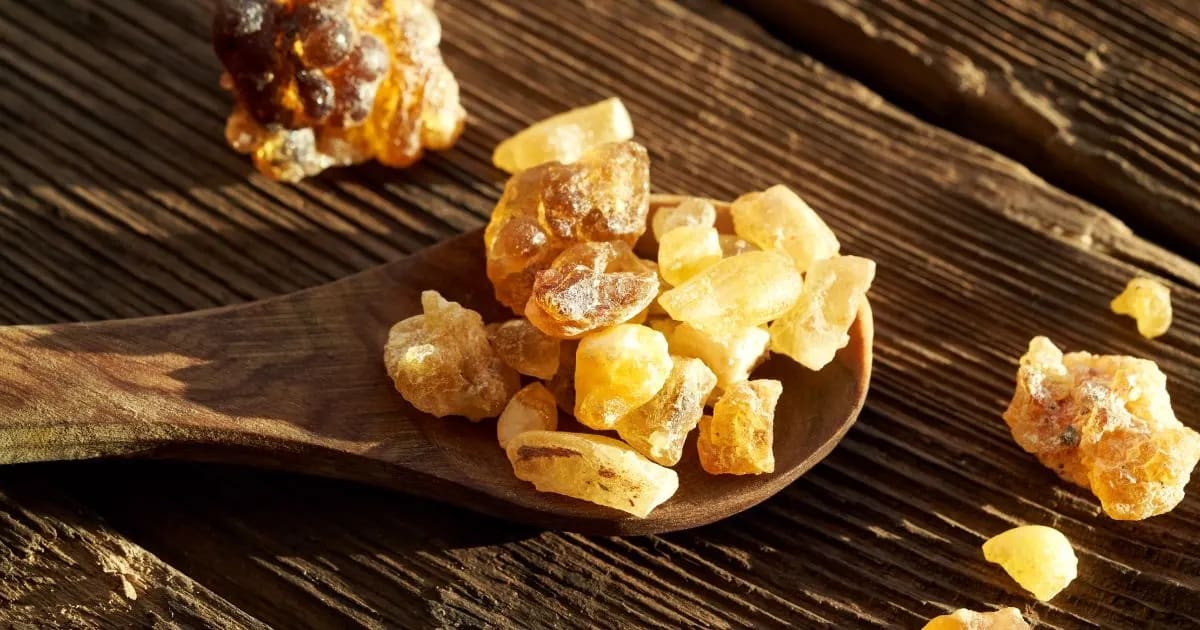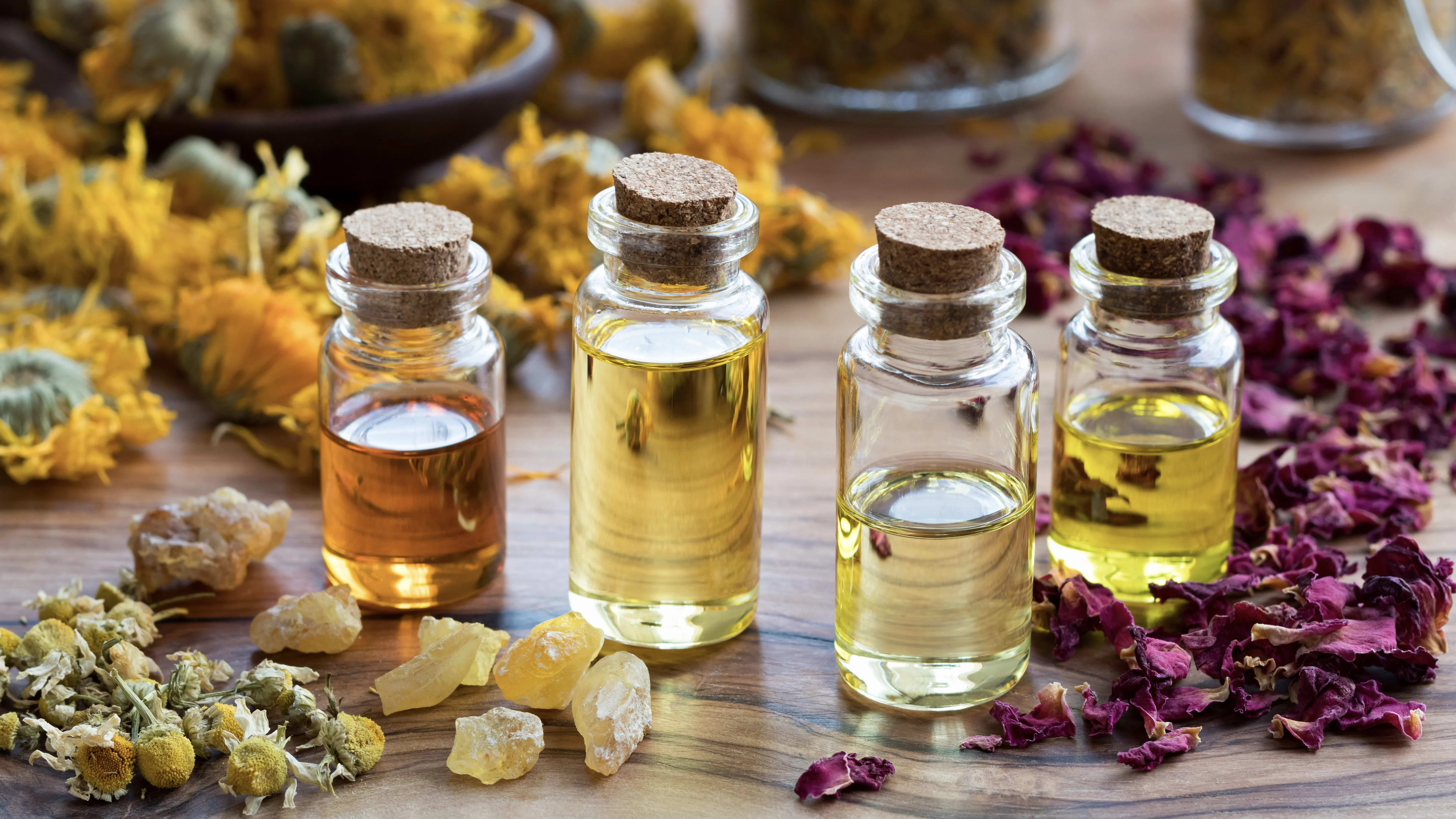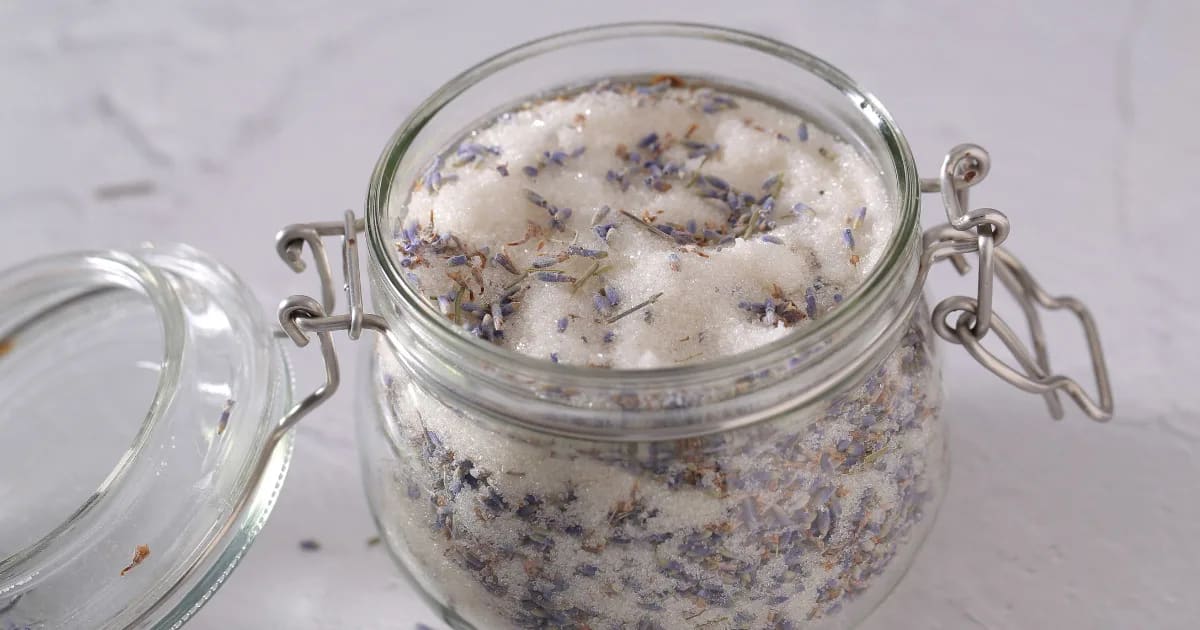Frankincense Essential Oil Benefits: Skin Care, Aromatherapy Uses, and Traditional Healing with Boswellia Oil

An Ode to Frankincense Oil
Imagine standing among sun-drenched hills in the Middle East, where the gnarled frankincense trees rise like sentinels over the dry earth. Their bark bears the memory of centuries of healing, and from tiny wounds in the trees, a resin emerges that has captivated humanity for millennia. From this gum resin comes the essential oil we treasure today.
From the first time I inhaled frankincense oil’s deep, resinous aroma, I felt a sense of calm and connection, as if the oil itself had a story to tell. Over the years, it has become one of my most trusted companions. Frankincense oil invites us to slow down, breathe deeply, and reconnect with the powerful core of our being, where healing arises.
In this post, I’ll guide you through frankincense oil’s origins and production, explore the chemistry behind its soothing, grounding effects, and share its many benefits and uses. You’ll also find insights into how to use it safely, along with tips for incorporating it into your own daily practices.
By the end, my hope is that you’ll not only understand why frankincense has been revered for thousands of years, but also feel inspired to discover your own favorite ways to experience its gentle magic.
Origins and Production: From Gum Resin to Pure Essential Oil
Frankincense essential oil carries a story as ancient and rich as the Middle Eastern landscapes, where the trees grow. The heart of frankincense lies in the gum resin, which the tree sends forth in response to a wound on its bark. This resin creates a protective seal over the wound. It’s a healing balm for the tree’s skin, a metaphor that speaks to the oil’s profound benefits for our own wellbeing.
There are several types of frankincense oils we use for essential oil distillation. Boswellia carterii (a popular species) and Boswellia frereana, with its sweeter, softer aroma, are commonly sourced from the rugged hills of Somaliland, where harvesting the gum resin is both a livelihood and a cultural heritage. Boswellia serrata grows in the drier regions of India, where the tapping and collection of resin have been practiced for centuries. And Boswellia sacra comes from Oman, where special permission to harvest it is required from the royal family.
These oils all offer a different profile, both in smell and chemical composition (which I’ll explore in a moment), yet all share a distinctive resinous scent that feels both grounding and elevating.
Frankincense essential oil is extracted through steam distillation, a time-honored process that transforms the precious gum resin into the gorgeous oil treasured in aromatherapy. This process gently coaxes out the oil’s fragrant molecules, preserving the essence of the tree’s healing spirit.
The resulting essential oil carries a deep, rich aroma, resinous and warm, with subtle undertones reminiscent of citrus oils, like lemon oil.
The resin itself has been valued for thousands of years in traditional medicine, beauty products, and incense. Traded along the storied Incense Route that wound through the Middle East and North Africa, it was once considered as valuable as gold. Ancient Egyptians burned frankincense resin in their temples to honor the gods, ground it into kohl for eye makeup, and used it in embalming rituals. The Babylonians and Assyrians offered its fragrant smoke to their deities, believing the rising tendrils of incense carried prayers to the heavens.
In the Greco-Roman world, frankincense was celebrated for its medicinal virtues as much as its ceremonial use. Pliny the Elder suggested it for wounds, digestion, and inflammation, while Roman households perfumed their gatherings with its aromatic smoke.
The Science of Frankincense Oil: What’s Inside?
The essential oil’s chemical profile is dominated by monoterpenes, especially α-pinene, which can make up around 30 to 70% of the oil depending on the species. α-Pinene carries a fresh, pine-like aroma and contributes to the oil’s anti-inflammatory and bronchodilator properties, supporting healthy respiratory function (Guimarães, Quintans & Quintans-Júnior, 2013; Salehi et al. 2019). Frankincense oil is also antimicrobial, able to fight a variety of bacteria and viruses (Da Silva et al. 2012; Astani, Reichling & Schnitzler, 2010). It helps calm stress and anxiety (Ikei & Miyazaki, 2016), supports immunity (Li et al. 2006), and nurtures a healthy memory (Hashemi & Ahmadi, 2023).
Other key components of frankincense oil include:
β-Myrcene, known for its calming effects and anti-inflammatory properties (Guimarães, Quintans & Quintans-Júnior, 2013; do Vale et al. 2002).
Sabinene, which can block inflammatory enzymes and offers a spicy, woody note that deepens the oil’s complexity (Tyagi et al. 2020).
d-Limonene, which helps calm anxiety and reduce inflammation, while bringing a subtle citrus brightness reminiscent of lemon (Lima et al. 2012; Baylac & Racine, 2003).
In some species like Boswellia serrata, α-thujene is also present, adding to the unique scent profile and bringing antimicrobial benefits (Sadhasivam, Palanivel & Ghosh, 2016).
Chemically, the profiles differ among species. Here’s what we often see in the oils:
Boswellia carterii typically contains about 33% α-pinene, 17% β-myrcene, 14% d-limonene, and smaller amounts of sabinene.
The sacra variety is richer in α-pinene (around 68%) with less limonene.
Boswellia serrata features a higher percentage of α-thujene (around 63%) alongside α-pinene and sabinene.
Frereana oils carry a unique balance of α-pinene (43%), α-thujene, p-cymene, and sabinene.
Frankincense Oil Benefits & Uses in Aromatherapy
Frankincense essential oil is a truly versatile gem among oils! Here’s a look at some of its most celebrated benefits and my favorite ways to use it.
Daily skin care to support a clear, even skin tone. It’s gentle enough for most skin types, including sensitive skin.
Calming redness in skin. (This linked post has a recipe including helichrysum, rose, and carrot seed. Frankincense would be a good substitute for any of those oils.)
Respiratory care, including for colds & flu, congestion, allergies, coughs, and bronchial issues.
Calming pain and inflammation. Frankincense is one of my favorite essential oils for headaches.
Immune support.
Stress and anxiety relief. It’s a favorite for meditation and relaxation.
Mental clarity and memory. Use it to stay focused and present on a project.
Suggested Uses
Frankincense oil works great in your diffuser and in inhalers. And of course, it’s excellent for topical blends for your skin! I love it in lotions, body butters, massage oil and body oils, balms & salves, roller blends, deodorants, skin care products, and salt scrubs.
For skin application, always dilute essential oil with a carrier oil, such as jojoba oil (Simmondsia chinensis), sweet almond oil (Prunus amygdalus var dulcis), or coconut oil (Cocos nucifera). We recommend:
1% – 5–6 drops in 1 fl oz (30 ml) of carrier. For children between 5–10, seniors, and those with sensitivities.
2% – 10–12 drops in 1 fl oz (30 ml) of carrier. For everyday use, long-term (chronic) issues, and emotional support.
3% – 15–18 drops in 1 fl oz (30 ml) of carrier. For short-term acute use (about 2 weeks).
Frankincense Myths: Boswellic Acid & Cancer
I’ve seen a lot of excitement over emerging research showing that boswellic acids, found in frankincense resin, may have some uses for cancer care (including skin cancer) and reducing tumors. While those possibilities are promising, this research doesn’t apply to frankincense essential oil.
Boswellic acids are not present in the essential oil. They don’t come through the distillation process. This isn't to say that frankincense oil offers no benefits for us, but until more research is available, we can lean on its aromatherapy benefits for soothing anxiety and supporting us through any treatments we decide to receive.
Frankincense Essential Oil Safety and Storage
Frankincense essential oil is generally considered safe, especially when used thoughtfully and properly diluted to avoid skin irritation.
I do want to address internal use, since there can be some confusion here. Some cultures have a long history of using frankincense internally for healing and wellness. However, they’re usually working with the resin or a different form of frankincense extract, not the essential oil. (Boswellic acids are even available as supplements. If you decide to go in this direction, be sure you're taking a pure, unadulterated supplement.)
Using the oils internally requires specialized training, to protect your liver and the internal balance of your body’s systems.
Frankincense is often adulterated, meaning it may be cut with synthetic substances or cheaper oils. This will reduce its therapeutic benefits, and may even lead to unwanted reactions. Make sure you’re working with pure essential oil from a trustworthy source that provides clear product details (like botanical name, product description, where it was sourced, and GC/MS data on the components). Follow our tips here to be sure your essential oils are pure.
Store your frankincense oil in a cool, dark place, away from sunlight and heat that could speed up oxidation and shorten its shelf life.
My Takeaway: The Timeless Gift of Frankincense Oil
The journey of frankincense, from the tree’s steady resilience to the nourishing oil in your bottle, is a story of healing and patience. Each drop carries the memory of the resin sealing a wound, a reminder that while some hurts may never completely disappear, nature knows how to mend itself over time. The oil helps us access our own deep reserves of healing for body, heart, and mind.
It’s a bridge between the ancient and the everyday, from the inner world to the outer. As you experiment with your own blends and favorite uses, may you discover the gentle magic of this timeless, grounding oil.
REFERENCES
Astani A, Reichling J, Schnitzler P (2010) Comparative study on the antiviral activity of selected monoterpenes derived from essential oils. Phytotherapy Research 24(5):673-9. doi: 10.1002/ptr.2955
Baylac, S. and Racine, P. (2003) Inhibition of 5-lipoxygenase by essential oils and other natural fragrant extracts. International Journal of Aromatherapy 13, 2/3, 138-142.
Da Silva AC, Lopes PM, de Azevedo MM, Costa DC, Alviano CS, Alviano DS. (2012) Biological activities of a-pinene and ß-pinene enantiomers. Molecules 2012 17, 6305–16.
do Vale, T. G., Furtado, E. C., Santos, J. G., Jr, & Viana, G. S. (2002). Central effects of citral, myrcene and limonene, constituents of essential oil chemotypes from Lippia alba (Mill.) n.e. Brown. Phytomedicine : international journal of phytotherapy and phytopharmacology, 9(8), 709–714. https://doi.org/10.1078/094471102321621304
Guimarães AG, Quintans JSS, Quintans-Júnior LJ. (2013) Monoterpenes with analgesic activity – a systematic review. Phytotherapy Research 27,1-15.
Hashemi, P., & Ahmadi, S. (2023). Alpha-pinene moderates memory impairment induced by kainic acid via improving the BDNF/TrkB/CREB signaling pathway in rat hippocampus. Frontiers in molecular neuroscience, 16, 1202232. https://doi.org/10.3389/fnmol.2023.1202232
Ikei, H., Song, C., Miyazaki, Y. (2016). Effects of olfactory stimulation by α-pinene on autonomic nervous activity. Journal of Wood Science, 62(6). DOI:10.1007/s10086-016-1576-1
Li, Q., Nakadai, A., Matsushima, H., Miyazaki, Y., Krensky, A. M., Kawada, T., & Morimoto, K. (2006). Phytoncides (wood essential oils) induce human natural killer cell activity. Immunopharmacology and immunotoxicology, 28(2), 319-333. https://doi.org/10.1080/08923970600809439
Lima, N.G., de Souza, D.P., Pimenta, F.C., Alves, M.F., de Souza, F.S., (2012) Anxiolytic-like activity and GC-MS analysis of (R)-(+)-limonene fragrance, a natural compound found in foods and plants. Pharmacology, Biochemistry and Behavior 103, 450-454.
Sadhasivam, S., Palanivel, S., & Ghosh, S. (2016). Synergistic antimicrobial activity of Boswellia serrata Roxb. ex Colebr. (Burseraceae) essential oil with various azoles against pathogens associated with skin, scalp and nail infections. Letters in applied microbiology, 63(6), 495–501. https://doi.org/10.1111/lam.12683
Salehi, B., Upadhyay, S., Erdogan Orhan, I., Kumar Jugran, A., L D Jayaweera, S., A Dias, D., Sharopov, F., Taheri, Y., Martins, N., Baghalpour, N., Cho, W. C., & Sharifi-Rad, J. (2019). Therapeutic Potential of α- and β-Pinene: A Miracle Gift of Nature. Biomolecules, 9(11), 738. https://doi.org/10.3390/biom9110738
Tyagi, V., Singh, V. K., Sharma, P. K., & Singh, V. (2020). Essential oil-based nanostructures for inflammation and rheumatoid arthritis. Journal of Drug Delivery Science and Technology, 60, 101983.https://doi.org/10.1016/j.jddst.2020.101983





